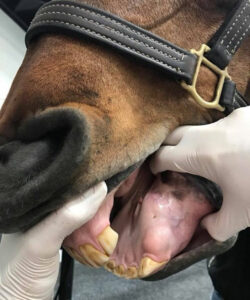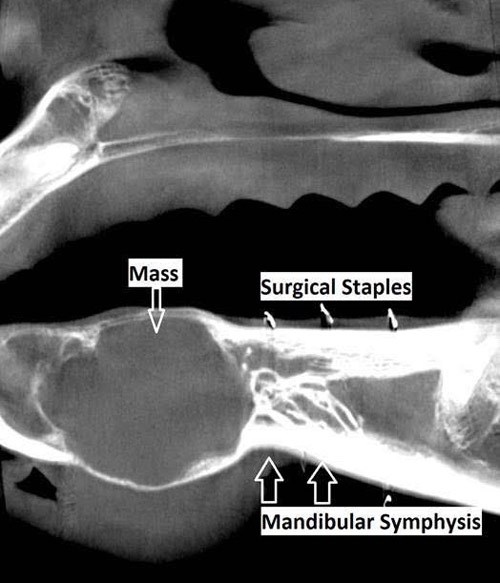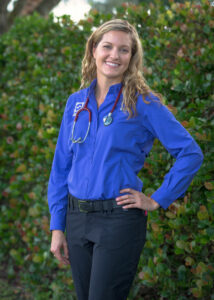Month: May 2018
Success Story: Ameloblastic Fibroma
When a middle-aged mare with a mysterious mass in her mouth came under the care of Palm Beach Equine Clinic in Wellington, FL, Dr. Weston Davis pulled out all the stops to find a definitive diagnosis. The oral mass was growing at a rapid rate and was positioned just behind the bottom incisors on the left bar of the horse’s mouth.

A view of the oral mass being examined by Dr. Davis.
Computed Tomography Imaging
First, Dr. Davis turned to the use of PBEC’s state-of-the-art computed tomography (CT) machine to obtain an image of the mass and its exact location within the horse’s mouth. Then, a surgical biopsy was performed and the histopathology, or microscopic examination of the biopsied tissue, revealed the manifestation of an ameloblastic fibroma. An ameloblastic fibroma is a mixed odontogenic (dental) tumor composed of soft tissues.
“Although this tumor type rarely metastasizes, it tends to be locally invasive and aggressive, requiring the complete removal and/or aggressive radiation therapy,” said Dr. Davis, who is a board-certified surgeon at PBEC.

Ameloblastic Fibroma Treatment Plan
A tumor of dental origin is rarely found in humans and is extremely rare in equines, but upon diagnosis, Dr. Davis quickly identified a treatment plan, saying, “In this case, the CT mapping that was performed enabled us to completely remove the tumor via a rostral mandibulectomy with preservation of the mandibular symphysis (the joint between the two halves of the mandible).”

The horse underwent surgery at PBEC and Dr. Davis removed the tumor along with the rostral (front) mandible, which includes the lower incisor teeth and essentially the entire front portion of the lower jaw of the horse.
The obvious question that arises from a rostral mandibulectomy is “how effectively will the horse be able to eat without bottom teeth?” For this patient, however, the answer came quickly and it was nothing short of encouraging. The mare returned to eating just hours after surgery and, at her two-week checkup with Dr. Davis, was back on a normal diet of hay, grain, and – of course – treats.
According to Dr. Davis, the majority of animals that undergo this type of surgery often compensate well and have little trouble eating. For this mare, her only struggle in the future may be the prehension of very short and/or tough pasture.

A view of the lower lip of the horse after surgery. 
Two weeks post-surgery and no visible signs of a rostral mandibulectomy.
Post Mandibulectomy Surgery
Also at two weeks post-surgery, Dr. Davis approved the mare for light riding activity with a hackamore. The mare competed in the jumper ranks before surgery and at a four-week checkup, Dr. Davis gave the all-clear and the mare returned to full work. She even made a comeback in the competition ring at Palm Beach International Equestrian Center with very little visual evidence that a mandibulectomy was ever performed.
“This was a rare tumor and a rare surgery, but the horse recovered incredibly well and fast!” said Dr. Davis. “It was an excellent patient outcome. “I gave her the all-clear at four weeks post-surgery and she is already back to winning classes.”
All Photos Courtesy of Dr. Weston Davis
Meet PBEC Veterinarian Dr. Marilyn Connor
For some, becoming an equine veterinarian was always their calling. But, for Palm Beach Equine Clinic’s own Dr. Marilyn Connor, a diverse education and a healthy serving of life experience gave her options. Originally hailing from just north of Dallas, TX, Dr. Connor grew up around horses, but initially set her sights on going to medical school to study human medicine. Her undergraduate studies started at Tulane University in New Orleans, LA, before she transferred back to her home state of Texas to graduate in 2006 with honors from Texas A&M University with a Bachelor of Science degree in biomedical science and minors in chemistry and business.
After conducting a Master’s level research project on the effects of social stress on an animal model of multiple sclerosis, Dr. Connor broadened her horizons and moved to New York. While in New York, Dr. Connor spent three years as a research analyst and junior stock trader at a New York-based hedge fund. On her weekends, Dr. Connor volunteered at a therapeutic riding program in Brooklyn, NY, where she taught riding lessons to children, adults, and veterans. It was during her time volunteering at the therapeutic riding program, that Dr. Connor realized she wanted a career where she was able to help both people and animals. Ultimately, this passion lead her back to Texas where she attended four years of veterinary school at Texas A&M University.
Here’s the rest of Dr. Connor’s story
What led you to an internship at PBEC?
In veterinary medicine, unlike human medicine, it is optional to complete an internship after graduation before going into practice. It’s estimated that by completing an equine internship, because of the high caseload and number of hours worked, you gain anywhere from three to five years of experience. Because I was a non-traditional vet student, with a career before I started vet school, I really wanted to jumpstart my career so I could become an experienced veterinarian quickly. I felt that completing an internship was a good investment of my time, so I could get those additional hours of mentorship and become a excellent veterinarian. I considered many of the best practices in the country, mostly in California and Colorado, when searching for an internship. I met Dr. Swerdlin at an American Association of Equine Practitioners conference in Las Vegas two years ago and he invited me to come to Palm Beach Equine Clinic for a visit. I fell in love with the practice and the people, and felt the internship offered a good balance of autonomy to act as a doctor while still providing mentorship for a young veterinarian. One thing that’s unique about PBEC is that we have a full staff of technicians day and night so I knew, as an intern, I would be able to rest in the evenings so I could focus my time on learning and becoming a good veterinarian. In some practices, interns are expected to act as a doctor during the day, but at night they are required to come to the hospital to feed horses, cleaning stalls, or administer simple medications which could be done by a technician. Another big motivation for me was that we have so many doctors to collaborate with. During the peak of season, there are roughly 40 doctors here to learn and gain experience from. I was also impressed with the very diverse case load that comes into PBEC. Those are some of the reasons I joined PBEC as an intern in July 2017.

What is your experience with horses outside of being a veterinarian?
I like to say that I was riding horses since before I was born. My mom had horses and she rode while she was pregnant with me. When I was eight I got my first horse and rode western; mostly trails, pleasure, and a little bit of barrels, until I was twelve. Then I switched over to English riding and showed in both the Hunter and Jumper divisions until I was 18 and left for college. I didn’t have the means to bring a horse with me to school, so there was a period of about two years when I was only riding when I would come home.
During my sophomore year of college, I got a job at a barn exercising and training first and second-level dressage horses. Later in college, I had a friend who did competitive endurance racing and she had some spare horses that she needed ridden in competition so I did that and it’s something that I stayed with until today. As you can see, I have just about done it all when it comes to riding. I also have trained young horses and taught riding lessons since I was about 15 years old. After college, I spent some time teaching at a therapeutic riding center and this was one of the things that ultimately made me realize I wanted to be an equine veterinarian so that I could help both horses and the people that love them.
What is your typical day like at PBEC?
One of the things I love about being a veterinarian, is that no two days are the same! Most days, I come into the hospital first thing in the morning to, physical examinations and treatments on my hospitalized patients that are staying at PBEC. On some days, I manage anesthesia for the surgeries taking place at the clinic, so I must make sure the patient is physically healthy enough to handle anesthesia and undergo surgery. I then administer a combination of medications to induce and maintain them under general anesthesia for the surgery. I monitor them throughout the procedure and stay with them until they have fully recovered after surgery and are able to stand up and walk back to their stall. I am happy to report I will be staying on at Palm Beach Equine as an associate, so I am working on developing my client base within the clinic. now I make farm calls to see my patients and I also seeing many of the call-in appointments for routine veterinary care as well as daytime emergencies such as when people discover their horse has an injury or is sick. I have taken continuing education courses that are specific on dentistry, so I also see patients that require dental care such as having their teeth floated. I am also certified in veterinary chiropractic, so that’s another service that I bring to the clinic.
What’s your favorite kind of case to work on?
I like so many things about my job, but I really like helping my clients to maximize the health of their horses through nutrition, wellness care, and preventative medicine. I also like working with lameness in horses; diagnosing orthopedic conditions and treating them with a combination of traditional joint injections, regenerative medicine, rehabilitation, and alternative medicine. It’s very rewarding to help my equine patients to be able to do their job at a high level and stay sound. I also enjoy working with clients to understand things they can do to prevent their horse from needing those kind of interventions later on in life.
I do a lot of the veterinary care for the Vinceremos Therapeutic Riding Center, which PBEC supports. It is very rewarding to be able to give back to a cause that is important to me, but now in a different capacity as a veterinarian.
What do you enjoy most about working for PBEC?
One thing I enjoy about working at PBEC is that we are well-equipped with the most advanced technology and equipment rarely offered outside of a university setting. We have an amazing hospital facility, top quality surgeons, the latest in regenerative medicine, and the most advanced diagnostic tools including radiography, MRI, nuclear scintigraphy and our new Computed Tomography (CT) machine, which very few practices have. As a doctor, it is amazing to have every tool at my disposal, so I can provide the best quality veterinary care for my patients. But I think my favorite thing about working at PBEC and what really makes us unique as a practice is that we have an exceptional team of doctors with different backgrounds and slightly different skill sets. While every doctor essentially operates autonomously within the practice, it is still one big team. I have so many doctors I can call day or night if I am stumped on a case or need assurance that the treatment plan is appropriate. At PBEC we always collaborate to provide the best quality care for our patients.
